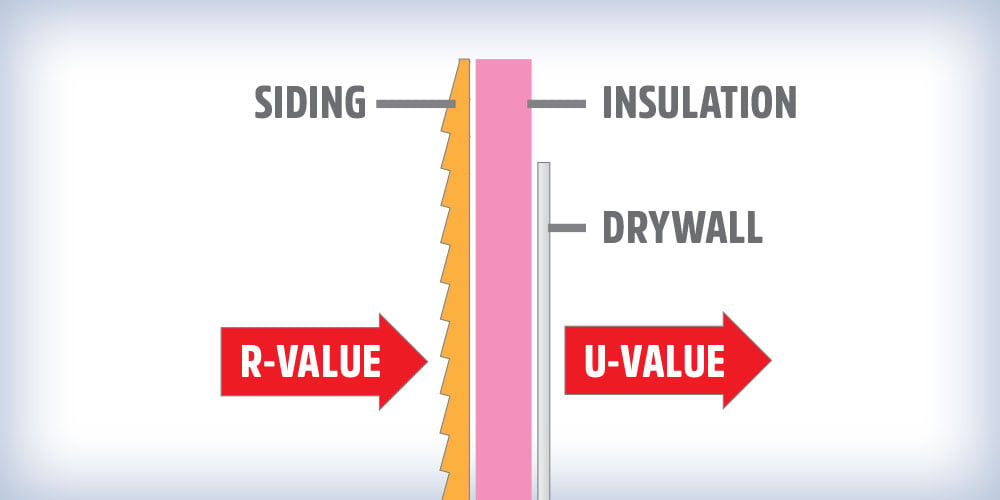Understanding R-Value and U-Value: The Key to Efficient Insulation


When it comes to insulating our homes, understanding the jargon can be as challenging as choosing the right type of insulation.
Two terms that often pop up are R-Value and U-Value.
Luckily, our network of RetroFoam dealers across the country understand exactly what R-Value and U-Value mean, and exactly how each pertains to home insulation.
Let's break down R-Value and U-Value in a simple, conversational manner so you can make an informed decision about your home's insulation.
What is R-Value?
R-Value is a term thrown around a lot when discussing insulation, but what does it mean?
In simple terms, R-Value measures the resistance of an insulating material to heat flow. The higher the R-Value, the better the insulation's ability to resist heat flow.
Let’s use some science terms.
R-Value represents how well insulation resists heat transfer, specifically through conduction. Conduction is the process where heat moves directly through materials. Traditional insulation materials are designed primarily to block this kind of heat transfer. However, there's more to the story when it comes to insulation types like spray foam and injection foam.
Foam insulation doesn’t just hinder conduction; it also tackles heat transfer through convection as well. Convection involves the movement of air, which can carry heat away. By creating a robust air seal, both spray foam and injection foam effectively limit this air movement.
We’ll talk more about air seal in a minute, but first let’s get back into why R-Value is important.
Why Does R-Value Matter?
Imagine your home as a thermos.
You want your hot drinks to stay hot and your cold beverages to stay cold, right? That's exactly what insulation with a high R-Value does for your home. It keeps the warm air in during winter and out during summer, making your home more energy-efficient.
Exploring U-Value
While R-Value gets a lot of attention, U-Value is equally important.
U-Value measures the amount of heat that is lost through a material.
Unlike R-Value, with U-Value, lower numbers are better. A low U-Value means less heat is escaping, which is great for insulation.
U-Value in Action
Think of U-Value as the leakiness of a window.
If you have a window with a high U-Value, it's like having a leaky window where heat can easily escape. A low U-Value window, however, is like having a well-sealed window that keeps the heat inside.
The Relationship Between R-Value and U-Value
Understanding the relationship between R-Value and U-Value is crucial.
They are two sides of the same coin. R-Value focuses on the material's resistance to heat flow, while U-Value measures how much heat is actually lost.
A well-insulated home must balance both high R-Value and low U-Value materials. This balance ensures maximum energy efficiency, keeping your home cozy in winter and cool in summer.
Practical Applications in Your Home: Insulation and Doors and Windows
When considering insulation for your walls, the emphasis should be on materials that boast a high R-Value if creating an air seal with foam isn’t on the table.
The R-Value is a clear indicator of the insulation’s ability to resist the passage of heat.
Essentially, a higher R-Value means better insulation properties. This is crucial for walls, as they are one of the primary barriers against external temperatures. With high R-Value insulation, your walls become more effective at trapping heat inside during the colder months. This retention of warmth leads to a noticeable reduction in heating costs, as your home heating system doesn't have to work overtime to maintain a comfortable temperature.
Moreover, high R-Value insulation in walls can also play a significant role in enhancing your home's overall energy efficiency. By maintaining a stable internal temperature, it reduces the strain on heating and cooling systems, leading to less energy consumption and, consequently, lower utility bills. Additionally, it contributes to a more consistent and comfortable indoor climate, eliminating cold spots and drafts that are common in poorly insulated homes.
In contrast, when it comes to windows and doors, the focus should shift to the U-Value.
Windows and doors are often the weak points in a home’s insulation, primarily because glass and thin materials are less insulating than wall structures. A low U-Value in these areas is essential as it indicates a lower rate of heat transfer. This means that the windows and doors are better at keeping heat inside during winter and outside during summer.
Selecting windows and doors with a low U-Value involves considering various factors such as the type of glass, the presence of thermal breaks, and the overall design and material of the frame. Double or triple-glazed windows, for instance, offer significantly lower U-Values compared to single-glazed ones. These types of windows use multiple layers of glass with inert gas fills, like argon or krypton, between them, drastically reducing heat transfer.
In addition to reducing heat loss, windows and doors with low U-Values can also help mitigate condensation build-up, which is a common problem in areas with significant temperature differences between inside and outside. This not only improves comfort but also protects your windows and doors from moisture-related damages, such as mold and wood rot.
Overall, a strategic approach to insulation, focusing on high R-Value materials for walls and low U-Value components for windows and doors, can significantly enhance the energy efficiency and comfort of your home. This integrated approach ensures that every part of your home contributes to maintaining a stable, comfortable, and cost-effective living environment.
Knowing the U-Value Definition and Insulation R-Value
Understanding R-Value and U-Value is essential for any homeowner looking to improve their home's insulation.
Remember, your goals are a high R-Value for resistance and a low U-Value for minimal heat loss. Armed with this knowledge, you're now ready to make informed decisions about insulating your home for maximum comfort and efficiency.
Another thing to remember is that these numbers don’t tell the whole story, especially as it pertains to foam insulation.
The critical role of the air seal by foam insulation is what sets it apart. It's not just about slowing down heat flow; it's about keeping the conditioned air—whether warmed or cooled—right where you want it: inside your home. This comprehensive approach is why relying solely on R-Value doesn't always paint the full picture of an insulation's effectiveness.
The air seal created by foam insulation isn’t possible with materials like fiberglass and cellulose, both of which still allow for air movement. This is why when these materials are compared by performance and not R-Value, foam insulation comes out on top.
Making the Right Home Insulation Choice
Choosing the right insulation is a big decision, but it doesn't have to be complicated.
Keep all of the concepts you’ve just read about in mind, and you'll be well on your way to a more energy-efficient and comfortable home.
If you’re ready to take the next step, check out our Find a Dealer page to locate a RetroFoam dealer near you.
Related Articles
What is RetroFoam Injection Foam Insulation R-Value?
About Eric Garcia
Eric brings his knowledge and training in building science, training in spray and injection foams from the manufacturers, more than eight years installing foam insulation, as well as selling and managing in the foam insulation industry. He is also BPI and Dale Carnegie certified and has taken several building science courses, including air sealing and building envelope. Eric is the Professor of Foam on our educational YouTube series Foam University. Even when Eric is off he is usually still “working” or thinking about work, but when he can get away he enjoys camping, hiking, hunting, and woodworking.


